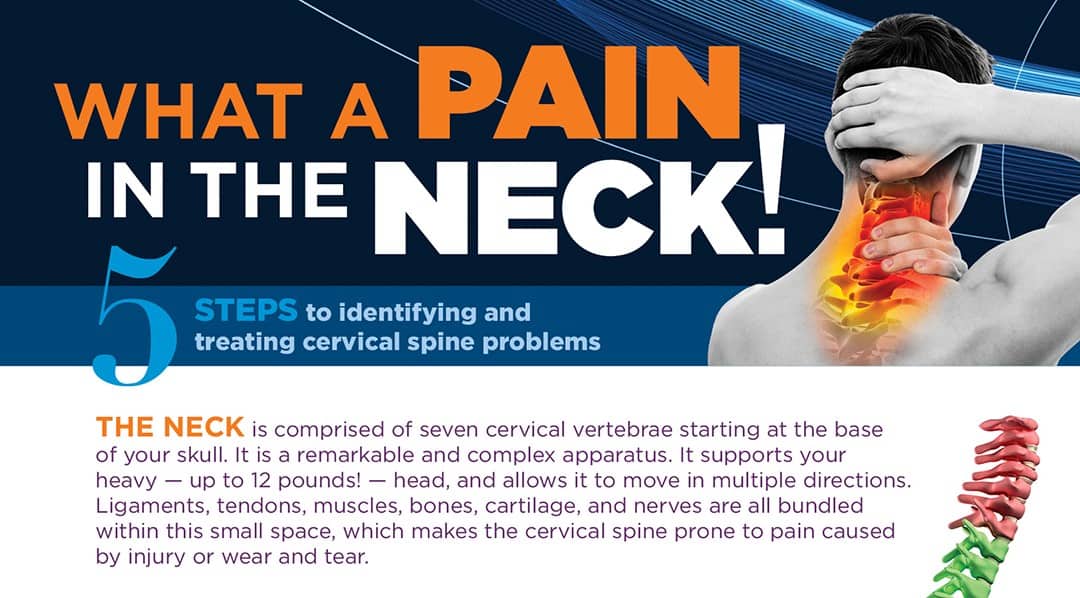Believe it or not, common types of neck pain are just as routine as colds or insomnia. In fact, as many as 1 in 5 adults have neck pain symptoms every year, and up to 70 percent of adults have reported having neck pain that interferes with their daily activities during their lifetime. I would say that up to 40 percent of patients I see at Neurosurgery One come in for neck pain treatment.
In today’s blog post, I’ll talk about the five most common types of neck pain, what they feel like and when you should seek medical care for your neck pain. This is the first of a four-blog series. The other blogs in this series are:
- Artificial cervical disc replacement for treating neck pain
- Three signs disc replacement might be right for you
- Recovering from neck surgery
Neck pain often starts with posture
While there are many factors that contribute to the prevalence of neck pain, posture is one of the top issues I see with patients. Many of us are attached to our phones and computers. Most of the time we hold our devices in our laps with our necks bent. Since the existence of humans, we have never spent 7-10 hours a day with our necks bent. It places extra pressure on our joints, and, honestly, we’re just not made to be looking down or at devices so much.
Neck pain isn’t always associated with posture and can originate from a range of activities, degenerative conditions, trauma, and more. Below I have unpacked 5 of the common types of neck pain and answered some of your top questions about neck pain including:
- What does neck pain feel like?
- When is it time to see a doctor for neck pain?
- What are some neck pain solutions?
For quick reference, we have created an infographic offers 5 steps to identifying and treating cervical spine problems, including the symptoms that require immediate medical attention.
Click on the image below to see and download the complete infographic.
Axial pain usually short lived
Axial neck pain is one of the most common types of neck pain. Some doctors refer to it as “mechanical neck pain.” If your pain feels dull or throbbing, you may have axial pain.
Axial neck pain, which can also be called acute neck pain, is commonly associated with pain that is centered in one part of your neck. The pain does not move, even if you move your neck around. Axial neck pain also does not radiate to your shoulders, arms, or hands. Axial neck pain may come from a muscle or ligament strain. You may have strained a muscle after stretching your neck or sleeping wrong. Looking at a computer or smart phone too long can also cause axial neck pain.
This type of neck pain is usually temporary. You don’t need to go to a doctor unless you experience very sharp or debilitating pain, or the pain persists for up to two weeks. Axial neck pain is often best treated—and avoided in the future—by making lifestyle changes like adjusting your pillows differently, improving your posture, and minimizing your time looking down at a computer or smartphone.
Muscle spasm from whiplash, trauma, or spinal disc damage
A muscle spasm is a sudden tightening of the muscles. It can occur in any part of the body, including in the neck. If you experience a sudden pain that feels tight or knotted, you may have a spasm.
Spasms can occur for several different reasons. A muscle strain can induce a spasm. Trauma like whiplash can also lead to neck muscle spasms. While most types of muscle spasms are temporary types of neck pain, more lasting neck pain associated with muscle spasms can result because of damage to a spinal disc.
If you experience just one spasm, you should try to relax your muscles and adjust your posture. If you have recurrent spasms, you should take note of when and where they occur. Spasms that occur after you move your spine may be due to a spinal problem, and you should see your primary care physician who can then assess your condition and refer you to a board-certified Denver neurosurgeon who specializes in spine issues.
Referred pain associated with issues beyond neck
Referred pain occurs when a health condition in one part of your body sets off pain in another part. For instance, if you encounter neck discomfort while you eat, you may have a problem with your esophagus. Neck pain after exercise could be a sign of weak circulation or heart disease. Or your neck pain could cause referred pain to other areas of your body, like when neck pain causes a headache or arm pain.
Referred pain from a headache can cause pain to radiate down into the neck. If you experience chronic headaches, you may experience chronic neck pain. Neck pain after a headache can feel dull, and it can occur in the upper part of the neck close to the skull. Chronic headaches or intense headaches that are not relieved with medication warrant a visit to your primary care provider and possibly a referral to a neurosurgeon. While rare, it’s important to determine if your headaches are associated with a structural abnormality like Chiari malformation or brain tumor.
Referred pain can feel like anything, which can make it tricky to identify. Often you may not even realize the pain in your neck is related to something else. You may mistake the pain for muscle strain or fatigue. You should go to your doctor if the pain becomes severe or if you develop any troubling symptoms like shortness of breath.
Radicular pain causes ‘pins and needles’ sensation
Radicular pain is nerve pain. This type of neck pain is also known as cervical radiculopathy and occurs when a root in a nerve becomes inflamed, damaged or compressed, resulting in pain in the neck. This usually occurs when a nerve within the spinal cord gets damaged in an accident or when nerve roots become pinched due to conditions like degenerative disc disease or osteoarthritis.
Radicular pain can be severe. Some people feel a searing pain as though they are being burned. Other people describe it as feeling like an electric shock. Radicular neck pain typically starts in the neck and then goes down the arm or wherever the damaged nerve extends. Turning your head or straining your neck may make the pain worse. Often people with radicular neck pain report loss of strength in their hand, shoulder, or arm. Others say their hand or fingers feel tingly.
Radicular pain is different than muscle spasms or axial pain as it feels more like a pinched nerve and is often accompanied by pain, numbness, or a tingly sensation in the shoulder, arm, or hand. Most radicular pain goes away on its own or with conservative treatment. If you experience radicular neck pain for longer than 6-12 weeks, you should see a spine specialist and you will need an MRI to determine the cause of the pain. If your pain is a result of spinal cord compression due to a degenerative spine condition, there are several conservative treatments such as physical therapy and spinal injections, which provide relief for the majority of patients. If conservative treatments are ineffective, anterior cervical discectomy and fusion (ACDF) and cervical disc replacement could provide relief.
Myelopathic pain caused by spinal cord dysfunction
Myelopathic pain, also referred to as cervical myelopathy, is a type of neck pain that occurs due to spinal cord dysfunction. The vertebrae in the neck can become compressed if enough pressure is put on them. Spondylolisthesis and cervical spinal stenosis can cause myelopathic pain.
Pain can become present in the neck and in other parts of the body. Some people experience discomfort or clumsiness in their arms and hands. Myelopathic pain may be achy or throbbing, and, in some cases, can cause balance issues and difficulty walking. If your pain has persisted for more than a few weeks, interferes with your daily habits, or gets worse, you should see a spine specialist.
Myelopathic pain may require neck surgery. It’s important for you to consult with a Denver neurosurgeon who specializes in spinal compression issues and spinal decompression surgery so that you can understand all your treatment options.
Treating neck pain
Neck pain doesn’t need to control your life and literally be a pain in your neck. Acute neck pain like axial pain is temporary and often resolves on its own or with slight modifications to your habits. More chronic neck pain that is caused by herniated discs, trauma, or degenerative spine conditions could warrant treatment.
For more information about neck pain, I recommend this infographic, What a Pain in the Neck, which offers 5 steps to identifying and treating cervical spine problems. Also, look for follow up blog posts about neck pain treatment options including cervical disc replacement and signs you may need artificial disc replacement




